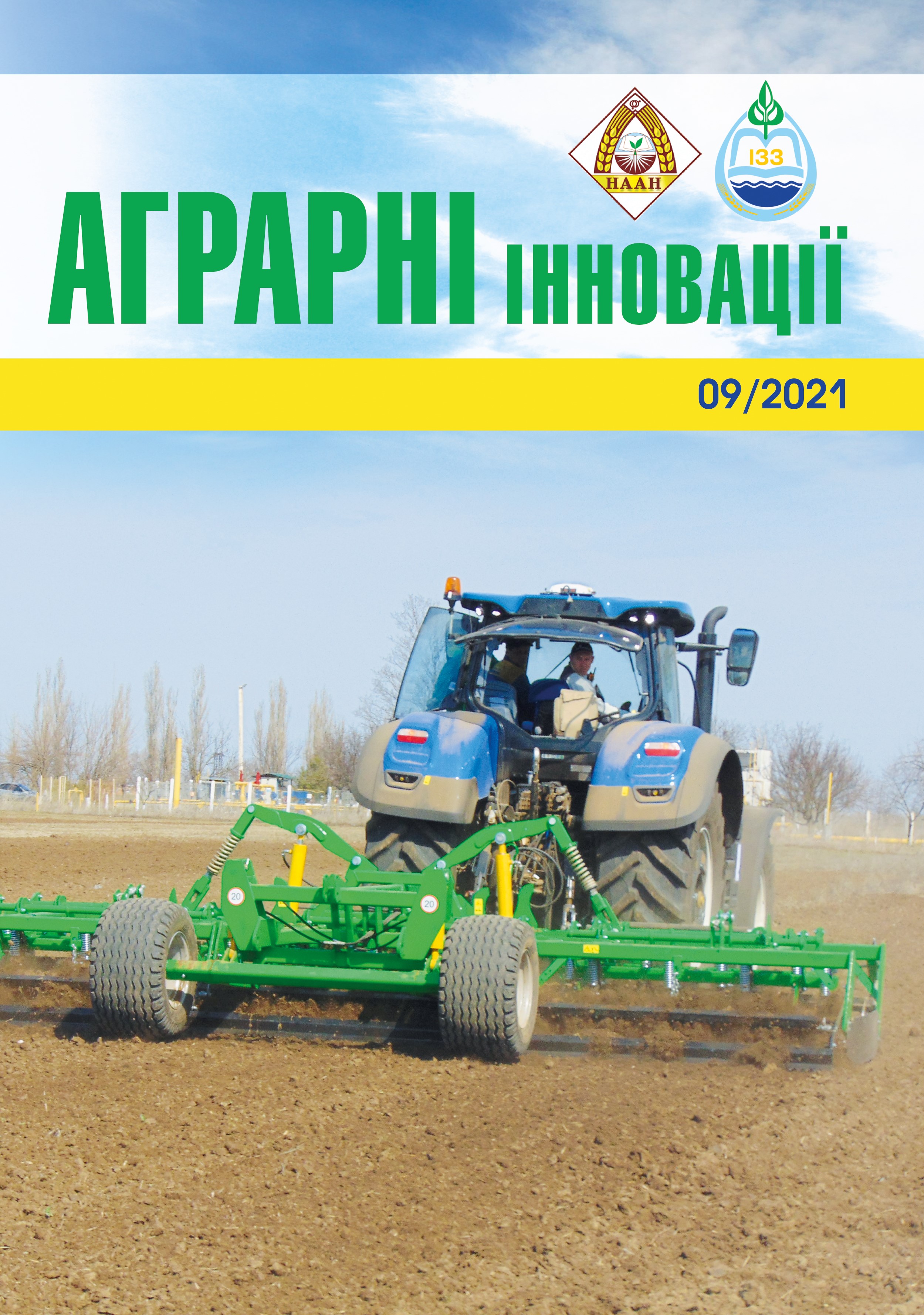Biologization of the technology of growing giant miscantus on biofuels
Abstract
Purpose. Currently, the study of ways to increase the amount of biomass of energy crops for biofuels is gaining relevance. Which is related to the possibility of obtaining additional energy from renewable plant resources. No less important factor is the ecology of the environment. After all, the cultivation of energy crops must minimize the impact on the environment and adhere to the principle of sustainability. Therefore, the aim of our study was to establish the impact of biologization of giant miscanthus cultivation, based on co-cultivation with legumes (without fertilizers) on biomass yield. The field experiment will be established and conducted in the central part of the Forest- Steppe on the basis of Poltava State Agrarian University. The soils of the research area are typical medium humus chernozems. Methods. During the research general and special methods were used: stationary field experiment, an alysis and generalization, variance and correlation analysis. General and special: stationary field experiment, analysis and generalization, analysis of variance and correlation. Results. According to the results of many years of research, an increase in the organic matter content of the soil has been established on the options of joint cultivation of giant miscanthus with legumes. The carbon deposition in the soil ranged from 1.56 to 3.27%. The upper part of the arable soil layer contained a higher percentage of organic matter, the lower – much less. An increase in the yield of green mass (up to 52.3 t/ha) and dry biomass (up to 15.6 t/ha) was determined by joint cultivation of threeyear- old giant miscanthus plants with perennial lupine. Combined cultivation of miscanthus with clover and alfalfa also increased yields, but only by 0.5 t/ha for dry biomass. In contrast, variants of giant miscanthus with lupine contributed to a significant increase in yield by 1.1 t/ha more than the control. Conclusions. It was found that the content of organic matter in the soil has a strong relationship with the yield of dry biomass of giant miscanthus in all variants of the experiment with correlation coefficients r ≥ 0.7. Thus, the use of co-cultivation of giant miscanthus with legumes contributes to the increase of organic matter in the soil while increasing biomass yields.
References
2. Кулик М.І., Падалка В.В. Розвиток біоенергетики на основі рослинного енергетичного ресурсу (на прикладі Полтавської області). Управління стратегіями випереджаючого інноваційного розвитку : монографія / за ред. к.е.н., доцента Н.С. Ілляшенко. Суми : Триторія, 2020. С. 109–118.
3. Пронько Л.М., Колесник Т.В. УМОВИ ТА ПЕРСПЕКТИВИ ВИРОБНИЦТВА І РЕАЛІЗАЦІЇ ПОНОВЛЮВАЛЬНИХ ДЖЕРЕЛ ЕНЕРГІЇ В УКРАЇНІ. Збірник наукових праць ВНАУ Серія: Економічні науки №1 (48) 2011. С. 185.
4. Пришляк Н.В. Потенційні можливості вирощування біоенергетичної сировини на виробництво твердого біопалива. Агросвіт. Вип. 1-2, 2021. С. 33–45. DOI: 10.32702/2306&6792.2021.1-2.33
5. Директива Європейського Парламенту та ради 2009/28/ЄС від 23 квітня 2009 року про заохочення до використання енергії, виробленої з відновлювальних джерел. [Електронний ресурс] : Офіційний вісник Європейського союзу – URL: http://saee.gov.ua/documents/dyrektyva_2009_28.pdf
6. Гументик М.Я., Квак В.М., Замойський О.І., та ін. (2015) Вплив елементів механізованої технології вирощування на продуктивність біомаси міскантусу. Вісник Дніпропетровського державного аграрно-економічного університету. вип. 4, С. 50–54.
7. Гументик М.Я. Особливості технології змішаного вирощування біоенергетичних злакових культур для виробництва біопалива. Біоенергетика. 2019. № 1. С. 16–18.
8. Caslin, B., Finnan J., Easson L. (2011). Miscanthus best practice guidelines Teagasc: Ecclesville Printing Services, V. 52 p. 91
9. Міскантус в Україні: колективна монографія. Колектив авторів. К.: ТОВ ЦП «Компрінт», 2019. 256 с.
10. Ганженко О.М. Технологія виробництва твердого біопалива з міскантусу / О.М. Ганженко, М.Я. Гументик, В.М. Квак // Біоенергетика. – 2015. № 2. С. 13–17. URL: http://nbuv.gov.ua/UJRN/Bioen_2015_2_6.
11. Способи підвищення виходу садивного матеріалу міскантусу гігантського / В.А. Доронін, В.В. Дрига, Ю.А. Кравченко, В.В. Доронін // Наукові праці Інституту біоенергетичних культур і цукрових буряків : зб. наук. праць / Ін-т біоенергет. культур і цукр. буряків, Нац. акад. аграр. наук України. К. : ФОП Корзун Д.Ю., 2018. Вип. 26. С. 11–20.
12. Міскантус в Україні : монографія / Роїк М. В. та ін. Київ : ФОП Ямчинський О.В., 2019. 256 с.
13. Роїк М.В., Курило В.Л., Гументик М.Я. та ін. Енергетичні культури для виробництва біопалива. Наукові праці Полтавської державної аграрної академії. 2010. Т. 7. С. 12–15.
14. Курило В.Л., Гументик М.Я., Квак В.М. Міскантус – перспективна енергетична культура для виробництва біопалива. Агробіологія. 2010. Вип. № 4 (80). С. 62–66.
15. Хіврич О.Б., Курило В.Л., Квак В.М. Енергетичні рослини, як сировина для біопалива. Пропозиція. 2011. Вип. № 6. С. 68.
16. Доспехов, Б.А. (1985). Методика полевого опыта. Москва: Колос. 416 с.
17. Ганженко О.М., Курило В.Л., Гументик М.Я., та ін. (2016) Методичні рекомендації з технології вирощування і переробляння міскантусу гігантського. К.: ТОВ «ЦП «Компринт», 40 с.
18. Рахметов Д.Б., Каленська С.М., Федорчук М.І., та ін. (2017) Методичні рекомендації з оптимізації технології вирощування міскантусу в різних грунтово-кліматичних зонах України. Видавничий центр «Колос»: ДВНЗ «Херсонський державний аграрний університет», 22 с.






